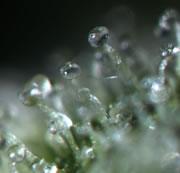 The active ingredient in cannabis leaves is in oils on the surface of leaf 'hairs'.Overgrow.com/norcan.org
The active ingredient in cannabis leaves is in oils on the surface of leaf 'hairs'.Overgrow.com/norcan.orgVaporizing cannabis leaves instead of burning them can release the drug's active ingredient just as effectively — while avoiding the harmful toxins inhaled through smoking the drug, according to a pilot study.
The result could be good news for those who choose to use marijuana medicinally.
The potential benefits of marijuana include pain relief for multiple-sclerosis sufferers, a treatment for glaucoma, as an appetite stimulant for AIDS patients and an anti-nausea agent for people on chemotherapy. But smoking isn't a good method of drug delivery because the harmful effects — such as lung cancer and heart disease — outweigh the likely merits of marijuana for all but terminal cases.
Rather than smoking, some use the leaves to make tea or cakes for consumption. But this means that the active agents are metabolized by the liver rather than entering the bloodstream unaltered. Others have focused on extracting active ingredients such as tetrahydrocannabinol (THC) and delivering them alone in a pill or oral spray. However, many think that the isolated ingredients are not as effective as the whole plant, and it is more difficult to customize the dose for each individual with a pill.
Hot stuff
Donald Abrams of the University of California, San Francisco, and his team decided to investigate the benefits of the 'Volcano', a commercially available vaporizer. The device heats marijuana leaves to a temperature between 180 and 200 °C so that THC is released from oils on the surface of the leaf but no actual combustion takes place.
Previous studies have shown that harmful toxins released through smoking cannabis such as carbon monoxide, benzene and a host of compounds known as polycyclic aromatic hydrocarbons (many of which are known carcinogens) are not produced by such devices.
Abrams' study is the first to compare the effects of smoking and vaporizing cannabis on human subjects. "We were able to deliver more-or-less equivalent amounts of THC into the bloodstream," he says. The main difference between the two delivery methods was that THC seemed to be absorbed into the bloodstream faster when using the vaporizer1. "The pharmacological and physiological effects were comparable," he says, although a larger study would be needed to prove that they are biologically equivalent.
Slow burn
The first studies to highlight the advantages of using vaporizers for cannabis were published more than five years ago, but the pace of research has been slow, partly because there is only one source of research-approved marijuana in the United States — the National Institute on Drug Abuse (NIDA) — which critics accuse of dictating research along a political agenda. A legal ruling this February recommended that the US Drug Enforcement Administration (DEA) end NIDA's monopoly on the production of marijuana for research approved by the US Food and Drug Administration and by the DEA.
ADVERTISEMENT
Laura Bell of the Multiple Sclerosis Society in the UK says that her society supports cannabinoid research for people with multiple sclerosis. "Smoking cannabis results in exposure to many toxic chemicals," she says. "We welcome research into better and safer delivery methods."
Cannabis leaf is not the only substrate suited to a vaporizer. Other herbal preparations, such as eucalyptus and chamomile can also be used, or any plant with medicinal properties in the volatile compounds of its leaves.
Visit our cannabiswithout_the.html">newsblog to read and post comments about this story.
